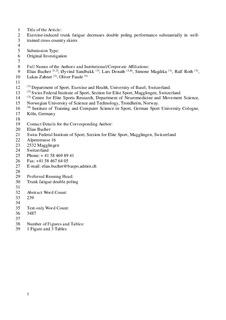| dc.contributor.author | Bucher, Elias | |
| dc.contributor.author | Sandbakk, Øyvind | |
| dc.contributor.author | Donath, Lars | |
| dc.contributor.author | Roth, Ralf | |
| dc.contributor.author | Zahner, Lukas | |
| dc.contributor.author | Faude, Oliver | |
| dc.date.accessioned | 2019-04-25T07:05:38Z | |
| dc.date.available | 2019-04-25T07:05:38Z | |
| dc.date.created | 2019-01-10T16:28:13Z | |
| dc.date.issued | 2018 | |
| dc.identifier.citation | European Journal of Applied Physiology. 2018, 118 (10), 2077-2087. | nb_NO |
| dc.identifier.issn | 1439-6319 | |
| dc.identifier.uri | http://hdl.handle.net/11250/2595342 | |
| dc.description.abstract | Purpose
To examine the effects of exercise-induced trunk fatigue on double poling performance, physiological responses and trunk strength in cross-country skiers.
Methods
Sixteen well-trained male cross-country skiers completed two identical pre- and post-performance tests, separated by either a 25-min trunk fatiguing exercise sequence or rest period in a randomized, controlled cross-over design. Performance tests consisted of a maximal trunk flexion and extension test, followed by a 3-min double poling (DP) test on a ski ergometer.
Results
Peak torque during isometric trunk flexion (− 66%, p < .001) and extension (− 7.4%, p = .03) decreased in the fatigue relative to the control condition. Mean external power output during DP decreased by 14% (p < .001) and could be attributed both to reduced work per cycle (− 9%, p = .019) and a reduced cycle rate (− 6%, p = .06). Coinciding physiological changes in peak oxygen uptake (− 6%, p < .001) and peak ventilation (− 7%, p < .001) could be observed. Skiers chose a more even-pacing strategy when fatigued, with the performance difference between fatigue and control condition being most prominent during the first 2 min of the post-test.
Conclusions
In well-trained cross-country skiers, exercise-induced trunk fatigue led to a substantial decrease in DP performance, caused by both decreased work per cycle and cycle rate and accompanied by reduced aerobic power. Hence, improved fatigue resistance of the trunk may therefore be of importance for high-intensity DP in cross-country skiing. | nb_NO |
| dc.language.iso | eng | nb_NO |
| dc.publisher | Springer Verlag | nb_NO |
| dc.title | Exercise-induced trunk fatigue decreases double poling performance in well-trained cross-country skiers | nb_NO |
| dc.type | Journal article | nb_NO |
| dc.type | Peer reviewed | nb_NO |
| dc.description.version | acceptedVersion | nb_NO |
| dc.source.pagenumber | 2077-2087 | nb_NO |
| dc.source.volume | 118 | nb_NO |
| dc.source.journal | European Journal of Applied Physiology | nb_NO |
| dc.source.issue | 10 | nb_NO |
| dc.identifier.doi | 10.1007/s00421-018-3938-4 | |
| dc.identifier.cristin | 1654414 | |
| dc.description.localcode | This is a post-peer-review, pre-copyedit version of an article published in [European Journal of Applied Physiology] Locked until 13.7.2019 due to copyright restrictions. The final authenticated version is available online at: https://doi.org/10.1007/s00421-018-3938-4 | nb_NO |
| cristin.unitcode | 194,65,30,0 | |
| cristin.unitname | Institutt for nevromedisin og bevegelsesvitenskap | |
| cristin.ispublished | true | |
| cristin.fulltext | postprint | |
| cristin.qualitycode | 1 | |
